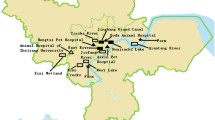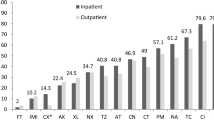Abstract
The aim of this study was to characterise the atypical enteropathogenic Escherichia coli (EPEC) strains isolated during a study of intestinal infectious disease in the UK by serotyping, intimin subtyping, and antimicrobial resistance typing. Serotypes, intimin subtypes, and resistance patterns of strains from cases were then compared with those from the control group. A wide range of serotypes, intimin subtypes, and antimicrobial resistance patterns was identified in isolates from both cases and controls, with O70:H11 and O111:H− being the most frequently detected serotypes. The most common intimin types were γ and γ2. Thirty-six percent of the EPEC isolates were resistant to at least one antimicrobial agent. No significant differences in the characteristics of EPEC strains isolated from patients with symptoms of gastrointestinal disease versus those isolated from healthy controls were detected, although strains harbouring the β-intimin subtype were more commonly isolated from children under 5 years of age (p=0.002). The compilation of data on atypical EPEC strains presented here indicates the need for further study of their virulence and epidemiology in order to assess their significance as human pathogens.
Similar content being viewed by others
References
Nataro JP, Kaper JB (1998) Diarrheagenic Escherichia coli. Clin Microbiol Rev 11:142–201
Smith HR, Scotland SM, Cheasty T, Willshaw G, Rowe B (1996) Enteropathogenic Escherichia coli in the United Kingdom. Rev Microbiol 27(Suppl 1):45–49
Mani R, Udgaonkar U, Pawar S (2003) Study of enteropathogenic Escherichia coli (EPEC) diarrhoea in children. Indian J Pathol Microbiol 46:118–120
Ratchtrachenchai OA, Subpasu S, Hayashi H, Ba-Thein W (2004) Prevalence of childhood diarrhoea-associated Escherichia coli in Thailand. J Med Microbiol 53:237–243
Kaper JB (1996) Defining EPEC. Rev Microbiol 27:13–23
Jerse AE, Yu J, Tall BD, Kaper JB (1990) A genetic locus of enteropathogenic Escherichia coli necessary for the production of attaching and effacing lesions on tissue culture cells. Proc Natl Acad Sci USA 87:7839–7843
Jenkins C, Lawson AJ, Cheasty T, Willshaw GA, Wright P, Dougan G, Frankel G, Smith HR (2003) Subtyping intimin genes from enteropathogenic Escherichia coli associated with outbreaks and sporadic cases in the United Kingdom and Eire. Mol Cell Probes 17:149–156
Blanco M, Schumacher S, Tasara T, Zweifel C, Blanco JE, Dahbi G, Blanco J, Stephan R (2005) Serotypes, intimin variants and other virulence factors of eae-positive Escherichia coli strains isolated from healthy cattle in Switzerland. Identification of a new intimin variant gene (eae-eta2). BMC Microbiol 5:23
Trabulsi LR, Keller R, Gomes TAT (2002) Typical and atypical enteropathogenic Escherichia coli. Emerg Infect Dis 8:508–513
Wheeler JG, Sethi D, Cowden JM, Wall PG, Rodrigues CC, Hudson MJ, Roderick PJ (1999) Study of infectious intestinal disease in England: rates in the community, presenting to GPs and reported to national surveillance. BMJ 318:1046–1050
Tompkins DS, Hudson MJ, Smith HR, Eglin RP, Wheeler JG, Brett MM, Owen RJ, Brazier JS, Cumberland P, King V, Cook PE (1999) A study of infectious disease in England: microbiological findings in cases and controls. Commun Dis Public Health 2:108–113
Food Standards Agency (2000) A report of the study of infectious intestinal disease in England. The Stationery Office, London, UK
Sethi D, Wheeler JG, Cowen JM (1999) A study of infectious disease intestinal disease in England: plan and methods of data collection. Comm Dis Public Health 2:101–107
Nataro JP, Baldini MM, Kaper JB, Black RE, Bravo N, Levine MM (1985) Detection of an adherence factor of enteropathogenic Escherichia coli with a DNA probe. J Infect Dis 152:560–565
Gross RJ, Rowe B (1985) Serotyping of Escherichia coli. In: Sussman M (ed) The virulence of Escherichia coli. Cambridge University Press, Cambridge, UK, pp 345–360
Frost JA (1994) Testing for resistance to antibacterial drugs. In: Chart H (ed) Methods in practical laboratory bacteriology. CRC, Boca Raton, Florida, pp 73–82
Fitzhenry RJ, Reece S, Trabulsi LR, Heuschkel R, Murch S, Thomson M, Frankel G, Phillips AD (2002) Tissue tropism of enteropathogenic Escherichia coli strains belonging to the O55 serogroup. Infect Immun 70:4362–4368
Wilson A, Evans J, Chart H, Cheasty T, Wheeler JG, Tompkins D, Smith HR (2001) Characterisation of strains of enteroaggregative Escherichia coli isolated during the infectious intestinal disease study in England. Eur J Epidemiol 17:1125–1130
Knutton S, Shaw R, Phillips AD, Smith HR, Willshaw GA, Watson P, Price E (2001) Phenotypic and genetic analysis of Escherichia coli from children in the United Kingdom. J Ped Gastroenterol Nutr 33:32–40
Robins-Browne RM, Bordun AM, Tauschek M, Bennett-Wood VR, Russell J, Oppedisano F, Lister NA, Bettelheim KA, Fairley CK, Sinclair MI, Hellard ME (2004) Escherichia coli and community-acquired gastroenteritis, Melbourne, Australia. Emerg Infect Dis 10:1797–1805
Afset JE, Bergh K, Bevanger L (2003) High prevalence of atypical enteropathogenic Escherichia coli (EPEC) in Norwegian children with diarrhea. J Med Microbiol 52:1015–1019
Afset JE, Bevanger L, Romundstad P, Bergh K (2004) Association of atypical enteropathogenic Escherichia coli (EPEC) with prolonged diarrhoea. J Med Microbiol 53:1137–1144
Wight JP, Rhodes P, Chapman PA, Lee SM, Finner P (1997) Outbreaks of food poisoning in adults due to Escherichia coli O111 and Campylobacter associated with coach trips to northern France. Epidemiol Infect 119:9–14
Mundy R, Jenkins C, Yu J, Smith HR, Frankel G (2004) Distribution of espI among clinical enterohaemorrhagic and enteropathogenic Escherichia coli isolates. J Med Microbiol 53:1145–1149
Acknowledgements
This study was funded by the Department of Health and the Food Standards Agency. We would like to thank Judith Evans, Doreen Bassett, and Judith Lee for their contribution to this study. This paper is dedicated to the memory of Henry Smith, Ph.D.
Author information
Authors and Affiliations
Corresponding author
Rights and permissions
About this article
Cite this article
Jenkins, C., Smith, H.R., Lawson, A.J. et al. Serotypes, intimin subtypes, and antimicrobial resistance patterns of atypical enteropathogenic Escherichia coli isolated in England from 1993 to 1996. Eur J Clin Microbiol Infect Dis 25, 19–24 (2006). https://doi.org/10.1007/s10096-005-0075-x
Published:
Issue Date:
DOI: https://doi.org/10.1007/s10096-005-0075-x




